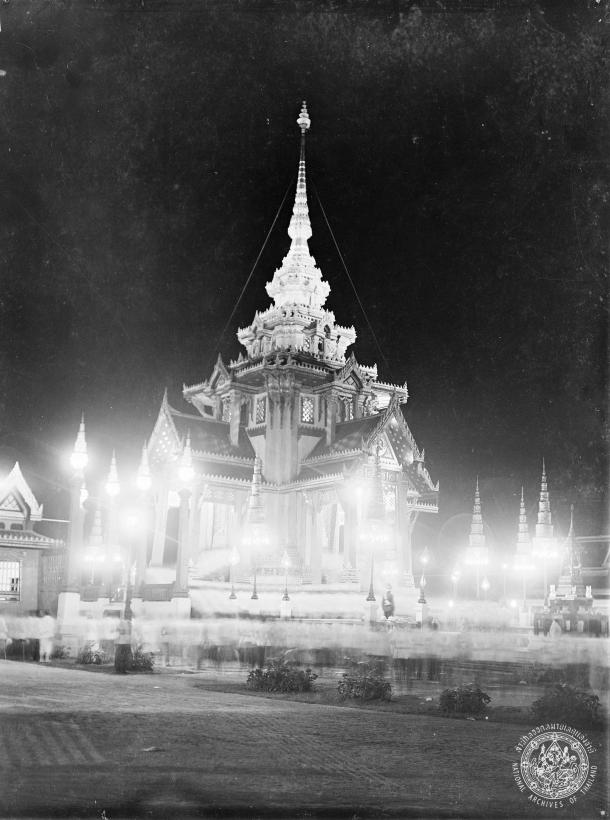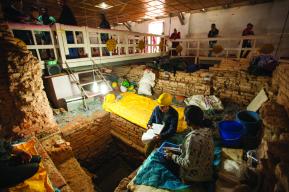Words by
Chairat Chongvattanakij
Consultant
Communications and Public Engagement Team
UNESCO Regional Office in Bangkok
Everybody in the room held their breath.
On the table lay an oblong, century-old teak box, within which 60 fragile glass plate negatives stood in a neat row. Specially attired for the occasion, Sumongkol Suahem, who works as part of the experienced documentary preservation team at the National Archives of Thailand (NAT), gingerly lifted one of them with gloved hands and let it hover over a light source to reveal a snapshot of history captured for posterity with astonishing clarity.

Sumongkol Suahem lifting a glass plate negative
It was indeed a rare visual treat. Normally kept in a rather forbidding, climate-controlled storage room, the treasured glass plate negatives in the teak box, which represent just a fraction of the enormous collection in the care of NAT since 1977, are so zealously safeguarded that even the archives’ director, Nitcha Jariyasetkarn, remarked good-humouredly, 'I don’t usually get to see them!'

The storage room for glass plate negatives, National Archives of Thailand
Dating from 1855 to 1935, the collection of over 35,000 glass plate negatives and some 50,000 prints—originally issuing from the private collections of King Chulalongkorn (Rama V), King Vajiravudh (Rama VI), and Prince Damrong Rajanubhab—had once been kept at the Phra Vajirayana Royal Library, the forerunner of today’s National Library of Thailand. The collection covers such an extensive time period that some of the photos encapsulate entire human lifespans. Consider, for example, the photo of Prince Asdang Dejavudh (1889–1924), son of King Chulalongkorn and Queen Saovabha Phongsri, as a playful young boy.

The young Prince Asdang Dejavudh
Poignantly, another photo in the collection documents the crematorium of the same prince, who would succumb to kidney disease at the age of 35.

The crematorium of Prince Asdang Dejavudh
Ms Nitcha explained that many of the photos form a crucial body of documentary evidence of how ceremonies such as royal funerals and royal barge processions were conducted in the past, thereby contributing to the continuity of royal traditions to the present day.

Royal barges at Wat Arun, 25 October 1907
Other photos provide a vivid record of King Chulalongkorn’s historic trip to Europe in 1897, during which he secured audiences with Otto von Bismarck and Tsar Nicholas II in a strategic manoeuvre to cultivate diplomatic relations and counter the colonial ambitions of Britain and France.

King Chulalongkorn meets Otto von Bismarck in Hamburg, 1897

King Chulalongkorn and Tsar Nicholas II in St. Petersburg, 1897
The photos in the royal collection not only chronicle special occasions of national and international significance; they often offer an unexpectedly intimate glimpse into everyday palace life. At a time when conservative courtiers harboured superstitions that photography would capture their souls and cause untimely death, King Mongkut (r. 1851–1868) and the succeeding King Chulalongkorn (r. 1868–1910) enthusiastically embraced the relatively new technology. According to Savitri Suwansathit, vice-chair of the Thai National Committee on the Memory of the World Programme of UNESCO, King Chulalongkorn encouraged the ladies of the court to practice photography, and the five consorts from the Bunnag family (known collectively as 'Chaochom Kok Aw') would come to be especially admired for their photographic skills and artistry.

Chaochom Erb, one of the 'Chaochom Kok Aw', preparing to take a photo of her father, Chaophraya Suraphanphisut (Thet Bunnag)
One extraordinary photo of King Chulalongkorn in his later years shows him pensively looking out of the window at Vimanmek Mansion. In a captivating contrast to formal portrayals of the monarch in full royal regalia, the photo makes the viewer almost feel like an intruder upon a rarely witnessed moment of private reflection.

King Chulalongkorn at Vimanmek Mansion
The collection also contains some spectacular visual records of various sites in the historic heart of Bangkok. For instance, Saphan Han (literally, 'turn bridge') was originally built during the reign of King Phutthayotfa Chulalok (Rama I, r. 1782–1809), and indeed a section of it would rotate to allow oversized vessels to pass unimpeded. The bridge subsequently underwent several reincarnations. Most notably, at King Chulalongkorn’s behest, Saphan Han was newly designed to incorporate features from two iconic bridges in Italy: the bowed expanse of the Rialto Bridge in Venice and the shops lining the Ponte Vecchio in Florence.

Saphan Han, as rebuilt during the reign of King Chulalongkorn
Today, visitors strolling along the Ong Ang Canal—revitalized in 2019 and since promoted as a tourist attraction—could casually cross Saphan Han in its comparatively modest current guise with little if any inkling of the bridge’s former glory.

Saphan Han in December 2023
Constructed contemporaneously with the Ong Ang Canal in 1783, the Maha Nak Canal begins its course just north of the towering Golden Mount of Wat Saket.

View of the Golden Mount from Maha Nak Canal
We can see that the Maha Nak Canal of bygone days was a key thoroughfare bustling with commercial activity.

The historic Maha Nak Canal
Today, the Maha Nak-Saen Saep canal route still serves as an essential transportation artery for tens of thousands of commuters every day. Walking along the Maha Nak Canal during morning rush hour, one witnesses express boats zipping by in both directions with deafening frequency.

View of Maha Nak Canal from Mahat Thai Uthit Bridge in December 2023
Another noteworthy photo from the royal collection shows us the newly opened Sala Chalermkrung Royal Theatre in 1933, when electric trams still operated along Charoen Krung Road.

The newly opened Sala Chalermkrung in 1933
Originally a movie theatre, Sala Chalermkrung has evolved into a renowned venue for performances of the masked dance drama known as Khon, which was inscribed on UNESCO’s Representative List of the Intangible Cultural Heritage of Humanity in 2018.

Sala Chalermkrung in December 2023
One of Bangkok’s most recognizable tourist attractions today, the Giant Swing in front of Wat Suthat was historically the site of the 'swing ceremony' performed as part of the Triyampawai Tripawai, the Hindu ritual in praise of Shiva and Vishnu. Nevertheless, serious injuries and fatal accidents led to the prohibition of the risky spectacle during the reign of King Prajadhipok (Rama VII, r. 1925–1935).

The swing ceremony in an earlier time
Enriched with the awareness of this historical context, stunningly preserved in the photo above as an arrested moment of death-defying import, one can visit the Giant Swing today with a deeper appreciation of its place in the cultural life of this storied city.

The base of the Giant Swing in December 2023
Without such exceptional snapshots of history, our collective memory and understanding of how the past connects to the present would be considerably impoverished. In recognition of the significance of this documentary heritage—both in regard to its content as well as the carrier of said content (namely, glass plates as a historic capture medium preceding the advent of photographic film)—the Royal Photographic Glass Plate Negatives and Original Prints Collection was inscribed on UNESCO’s Memory of the World International Register in 2017.
In keeping with the aims of UNESCO’s Memory of the World programme, Ms Nitcha said that the entire royal collection has been scanned and catalogued in an effort to improve accessibility, while also safeguarding the original documents.

Nitcha Jariyasetkarn holding mounted prints of Prince Damrong Rajanubhab
In addition, NAT has been raising awareness about this documentary heritage by organising exhibitions (one of which is still available in an engaging virtual format) and publishing two books of captioned photos from the royal collection thus far.
Ms Nitcha noted that it is not always clear what person, place, or event is being shown in certain photos, so NAT assembled a committee of experts from various fields to determine the most informative captions for them. In the near future, NAT plans to launch a digital platform for crowdsourcing inputs from the public, subject to expert verification, to enrich and expedite the captioning process.
With its staggering range of subject matter conveyed through the impactful immediacy of the visual medium, the Royal Photographic Collection introduces the curious viewer to a world of intriguing stories, wherein the relative brevity of an individual’s life is foregrounded against larger themes that reflect the persistence of collective human efforts across the generations to propel the social, economic, and cultural development of a nation dynamically in transition.
This is a lightly adapted version of an article that first appeared in the Bangkok Post, on 5 February 2024.
#DocumentaryHeritage #MemoryOfTheWorld
Images from the National Archives of Thailand, The Fine Arts Department may not be used or reproduced without the prior permission of the copyright holders.








